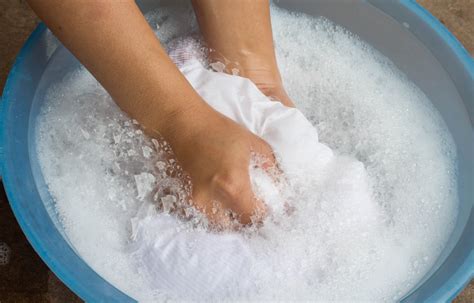The Ultimate Guide to Washing Delicate Fabrics
Delicate fabrics, with their luxurious textures and intricate weaves, require a gentle touch to maintain their beauty and longevity. From silk and lace to cashmere and linen, these fabrics demand special care to prevent damage and ensure their pristine condition. This comprehensive guide will delve into the intricacies of washing delicate fabrics, addressing common concerns and providing practical tips for achieving optimal results.
This guide covers essential aspects of washing delicate fabrics, including hand washing techniques, machine washing options, drying methods, and stain removal tips. We will also explore the specific characteristics of different delicate fabrics and their unique washing requirements. Whether you’re a seasoned laundry enthusiast or a novice seeking guidance, this resource will equip you with the knowledge and confidence to care for your precious garments.
So, let’s embark on this journey of understanding and mastering the art of washing delicate fabrics, ensuring that your cherished garments remain vibrant, soft, and ready to be treasured for years to come.
How do I wash delicate fabrics by hand?
Hand washing is often the preferred method for delicate fabrics, as it provides the most control and gentleness. Here’s a step-by-step guide to hand washing delicate fabrics:
- Gather Your Supplies: You’ll need a basin or sink filled with cool or lukewarm water, a mild detergent specifically designed for delicate fabrics, and a clean, dry towel.
- Prepare the Garment: Turn the garment inside out to protect any delicate embellishments or embroidery.
- Add Detergent: Add a small amount of detergent to the water and gently swirl it to create a sudsy solution.
- Soak the Garment: Submerge the garment in the soapy water and allow it to soak for 5-10 minutes. Avoid soaking delicate fabrics for prolonged periods, as it can weaken the fibers.
- Gently Wash: Using your hands, gently squeeze and swish the garment in the soapy water. Avoid rubbing or twisting the fabric, as this can cause damage.
- Rinse Thoroughly: Drain the soapy water and refill the basin with cool, clean water. Rinse the garment thoroughly until all traces of detergent are removed.
- Remove Excess Water: Gently squeeze out excess water from the garment. Do not wring or twist the fabric.
- Dry Gently: Lay the garment flat on a clean, dry towel. Gently roll the towel to absorb excess water. Alternatively, you can hang the garment on a padded hanger to air dry.
- Avoid Direct Sunlight: Direct sunlight can fade delicate fabrics, so dry the garment in a cool, shaded area.
By following these steps, you can effectively hand wash delicate fabrics without compromising their integrity.
What are some tips for washing delicate fabrics in a washing machine?
While hand washing is often recommended for delicate fabrics, it’s not always feasible. If you must machine wash delicate items, here are some tips to help you avoid damage:
- Select the Delicate Cycle: Your washing machine likely has a delicate cycle specifically designed for delicate fabrics. This cycle typically uses a gentler agitation and spin speed, minimizing stress on the fabric.
- Use a Laundry Bag: Enclose delicate garments in a mesh laundry bag to prevent them from snagging or becoming tangled with other laundry items.
- Turn the Garment Inside Out: Turning delicate items inside out will help protect delicate embellishments, embroidery, and intricate designs.
- Cold Water Wash: Cold water is generally safer for delicate fabrics as it helps prevent shrinking or color fading.
- Skip the Bleach: Bleach can be harsh on delicate fabrics and can cause discoloration. It’s best to avoid using bleach altogether when washing delicate items.
- Minimal Detergent: Use a small amount of mild detergent specifically designed for delicate fabrics. Avoid using harsh detergents, as they can strip natural fibers of their oils and weaken the fabric.
- Lower Spin Speed: Select a low spin speed during the washing cycle to reduce the amount of stress and agitation placed on the fabric.
By employing these techniques, you can minimize the risk of damage when machine washing delicate fabrics. Remember, it’s always advisable to check the care label on the garment for specific washing instructions.
What kind of detergent should I use for delicate fabrics?
Choosing the right detergent is crucial for maintaining the integrity of delicate fabrics. Here are some factors to consider:
- Delicate Formula: Opt for a detergent specifically formulated for delicate fabrics. These detergents are typically milder and contain fewer harsh chemicals that can damage delicate fibers.
- Natural Ingredients: Consider detergents with natural ingredients, such as plant-based enzymes or botanical extracts. These options can provide effective cleaning power without being overly harsh.
- Avoid Harsh Chemicals: Stay away from detergents containing bleach, optical brighteners, or strong fragrances, as these can damage delicate fabrics.
- Free and Clear Options: Look for detergents labeled as “free and clear” or “fragrance-free.” These options are often gentler on sensitive skin and can help prevent irritation from harsh chemicals.
- Test on an Inconspicuous Area: Before using any new detergent, test it on an inconspicuous area of the garment to ensure it doesn’t cause discoloration or damage.
By selecting a gentle and appropriate detergent, you can help preserve the beauty and longevity of your delicate fabrics.
How do I dry delicate fabrics properly?
Drying delicate fabrics is just as important as washing them. Here’s a comprehensive guide to drying delicate fabrics:
- Avoid Heat: High heat can damage delicate fabrics, leading to shrinkage, wrinkles, or even scorching. Avoid using a dryer or ironing delicate items at high temperatures.
- Air Drying: Air drying is the safest and most recommended method for delicate fabrics.
- Flat Drying: For delicate fabrics, such as lace, silk, or cashmere, flat drying is ideal. Lay the garment flat on a clean, dry towel.
- Hanging: Delicate fabrics can be hung on padded hangers to air dry. Choose a hanger that is wide enough to support the weight of the garment without causing any stretching or damage.
- Shade: Dry delicate fabrics in a cool, shaded area. Avoid direct sunlight, as it can cause fading or discoloration.
- Avoid Over Drying: Allow delicate fabrics to air dry completely before folding or storing them. Over drying can make them stiff and brittle.
- Reshaping: While the garment is still damp, gently reshape it to its original form.
By following these steps, you can dry delicate fabrics effectively and help prevent damage.
How do I remove stains from delicate fabrics?
Stains on delicate fabrics can be challenging to remove. Here are some tips for tackling common stains:
- Act Quickly: The sooner you treat a stain, the better your chances of removing it completely.
- Blot, Don’t Rub: Blot the stain gently with a clean cloth or sponge. Avoid rubbing, as this can push the stain deeper into the fabric.
- Mild Stain Remover: Use a mild stain remover specifically designed for delicate fabrics. Test it on an inconspicuous area of the garment before applying it to the stain.
- Cold Water: Use cold water to rinse the stain remover. Avoid using hot water, as it can set the stain.
- Professional Cleaning: For stubborn stains or delicate fabrics with intricate embellishments, it’s best to take the garment to a professional dry cleaner.
Remember to always check the care label on the garment for specific stain removal instructions.
How do I store delicate fabrics?
Proper storage is essential for preserving the quality and longevity of delicate fabrics. Here are some storage tips:
- Cleanliness: Make sure the garment is clean and dry before storing it.
- Folding or Hanging: Delicate fabrics can be folded or hung to store. If folding, use acid-free tissue paper to separate layers and prevent creasing. If hanging, use a wide, padded hanger to prevent stretching or damage.
- Storage Container: Store delicate fabrics in breathable cotton bags or garment bags. Avoid using plastic bags, as they can trap moisture and cause mildew.
- Cool and Dry Environment: Store delicate fabrics in a cool, dry environment, away from direct sunlight and heat.
- Moth Protection: Use cedar blocks or mothballs to protect delicate fabrics from moths.
By following these storage guidelines, you can ensure that your delicate fabrics remain in pristine condition for years to come.
What are some specific care instructions for different delicate fabrics?
Different delicate fabrics have unique characteristics and require specific care instructions. Here’s a breakdown of care recommendations for some common delicate fabrics:
Silk
- Hand Wash: Silk is a delicate fabric that’s best hand washed in cool water with a mild detergent.
- Avoid Wringing: Do not wring or twist silk fabric, as this can damage the fibers.
- Flat Drying: Lay silk garments flat to dry in a cool, shaded area.
- Ironing: Iron silk on a low setting, using a pressing cloth to protect the fabric.
Lace
- Hand Wash: Lace is delicate and easily damaged, so hand washing in cool water with a mild detergent is recommended.
- Gently Wash: Avoid rubbing or twisting lace, as this can cause snags or tears.
- Flat Drying: Lay lace garments flat on a clean towel to dry.
- Avoid Heat: Avoid using a dryer or ironing lace, as these can damage the delicate fabric.
Cashmere
- Hand Wash or Delicate Cycle: Cashmere can be hand washed in cool water with a mild detergent or washed on a delicate cycle in a washing machine.
- Gentle Agitation: Use a gentle washing motion and avoid twisting or wringing the fabric.
- Flat Drying: Lay cashmere garments flat to dry on a clean towel.
- Avoid Heat: Avoid using a dryer or ironing cashmere, as these can cause shrinkage or damage.
Linen
- Machine Wash: Linen can be machine washed on a gentle cycle in cool or lukewarm water.
- Avoid Harsh Detergents: Use a mild detergent and avoid using bleach or fabric softeners.
- Air Drying: Linen can be air dried or tumble dried on a low setting.
- Ironing: Linen can be ironed while it’s still damp for best results.
Understanding the specific care instructions for different delicate fabrics will ensure that your cherished garments remain in pristine condition for years to come.
Summary Table
| Fabric Type | Washing Method | Drying Method | Additional Tips |
|---|---|---|---|
| Silk | Hand wash in cool water with a mild detergent | Flat dry in a cool, shaded area | Avoid wringing or twisting. Iron on a low setting with a pressing cloth. |
| Lace | Hand wash in cool water with a mild detergent | Flat dry on a clean towel | Avoid rubbing or twisting. Avoid heat. |
| Cashmere | Hand wash in cool water with a mild detergent or delicate cycle in a washing machine | Flat dry on a clean towel | Gentle agitation. Avoid heat. |
| Linen | Machine wash on a gentle cycle in cool or lukewarm water | Air dry or tumble dry on a low setting | Avoid harsh detergents. Iron while damp. |
Frequently Asked Questions (FAQs)
What is the best way to wash delicate fabrics?
The best way to wash delicate fabrics depends on the fabric type and its care instructions. Hand washing in cool water with a mild detergent is often recommended for most delicate fabrics. However, some delicate fabrics, like linen, can be machine washed on a gentle cycle.
How do I prevent shrinkage when washing delicate fabrics?
To prevent shrinkage, wash delicate fabrics in cool water and avoid using a dryer. Air drying is always the safest option for delicate fabrics. Additionally, check the care label for specific instructions on preventing shrinkage.
Can I iron delicate fabrics?
Some delicate fabrics, like silk and linen, can be ironed, but it’s crucial to use a low heat setting and a pressing cloth to protect the fabric. Other delicate fabrics, like lace and cashmere, are best avoided ironing altogether.
Is it okay to use fabric softener on delicate fabrics?
Fabric softener can leave a residue on delicate fabrics and can make them feel stiff or scratchy. It’s best to avoid using fabric softener on delicate fabrics, especially silk, lace, and cashmere.
How often should I wash delicate fabrics?
The frequency of washing delicate fabrics depends on how often you wear them and the level of dirt or stains. However, delicate fabrics are generally more susceptible to damage, so it’s often best to wash them less frequently than other types of clothing.
What are some tips for taking care of delicate fabrics?
Some additional tips for taking care of delicate fabrics include:
- Turn garments inside out before washing or storing to protect embellishments or embroidery.
- Avoid using harsh detergents or bleaches on delicate fabrics.
- Store delicate fabrics in a cool, dry environment away from direct sunlight or heat.
- Consider taking delicate fabrics to a professional dry cleaner for stubborn stains or intricate embellishments.
Where can I find more information about washing delicate fabrics?
You can find additional information about washing delicate fabrics from reputable sources, such as:
- The care label on the garment
- Consumer Reports
- The Fabric Care Guide
- Online articles and forums
- Professional dry cleaners


